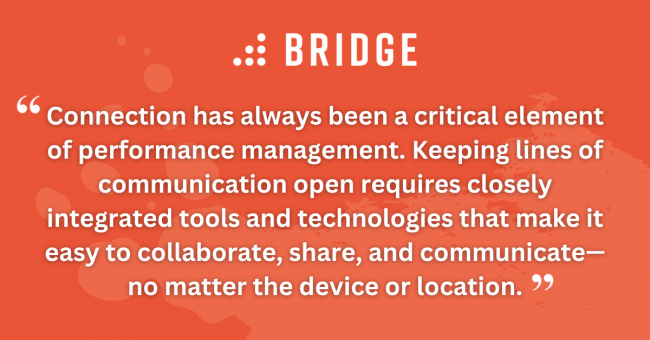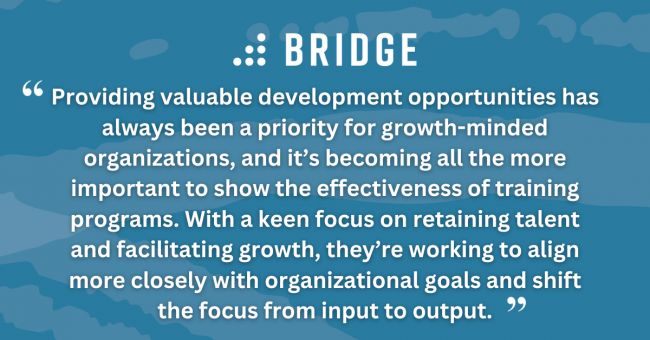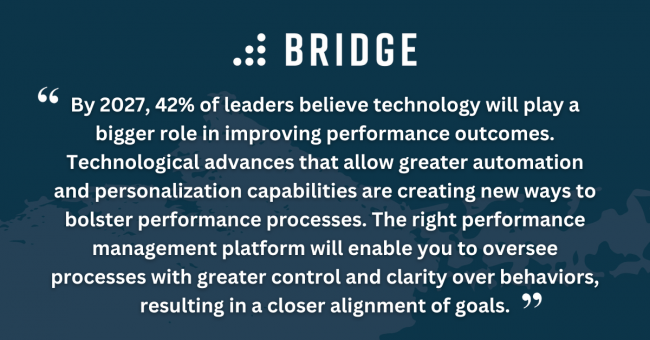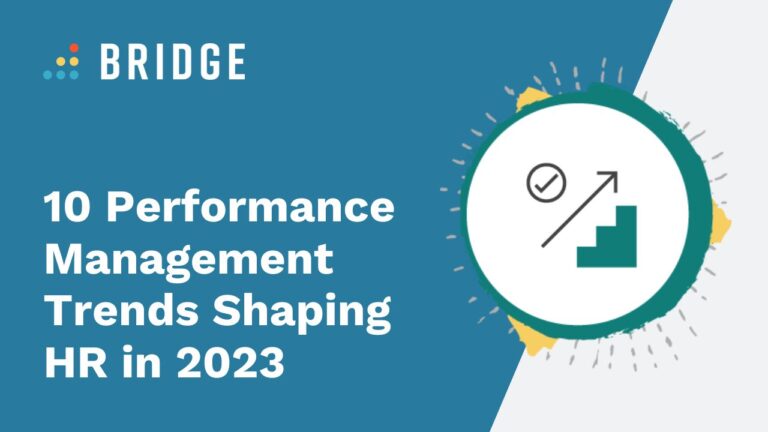As the world of work continues to change and evolve, so does the way organizations manage and evaluate employee performance.
Organizations are redefining their performance management processes, with a focus on the growing need to support skills development, enable collaboration and communication, and increase transparency into talent.
This focus on personalization and flexibility rather than fixed processes empowers people to do their best work.
Here are ten performance management trends we’ve spotted as we navigate through 2023 (and beyond!).
1) Opening Channels of Continuous Conversation
Performance management is about more than just measuring outcomes—it’s about supporting employees’ development and creating a culture that recognizes and celebrates achievements.
As Gartner observes, 52% of HR leaders don’t believe that they currently reward the right employee behavior, and three in four organizations have significantly changed their performance management processes to better meet their people’s needs.
Historically, performance reviews were seen as the gold standard for evaluating employees. However, organizations are moving away from once-a-year appraisals and making performance part of an ongoing dialogue.
By supporting employee development and engaging in continuous conversation, organizations are strengthening relationships and improving transparency into their talent through:
- Weekly one-on-ones and check-ins with managers
- 360 feedback assessments with peers, managers, and direct reports
- Employee recognition programs
RELATED READING | ‘Why Performance Reviews Shouldn’t Be a Once-a-Year Deal’
2) Connecting Communities Through Peer Mentoring and Feedback
As survey findings compiled by Gartner indicate, 77% of employees are increasingly looking to managers to support their development. However, findings also show that more than 50% of managers have more responsibilities than they can manage.
Organizations need to support their managers and ensure they have the time and resources to act as coaches and mentors.
In addition to incorporating tools and workflows to increase efficiencies and help managers to focus on their core strengths, organizations are also enabling collaboration in new ways to facilitate coaching and mentoring.
Peer feedback and mentoring, self-evaluations, and skills communities can provide deliberate ways of supporting development and growth. Organizations are unlocking effective performance outcomes by identifying and connecting people with mentors based on their goals and peers working toward shared goals.

BEST PRACTICES FOR COACHING AND MENTORING | ‘3 Elements of a Successful Mentorship Program’
3) Supercharging Employee Growth With a Focus on Autonomy
Adopting agile ways of working means that many organizations are shifting from a transactional relationship with employees to one in which people become more active participants in their own performance.
McKinsey’s Performance Through People report outlines that organizations are effectively nurturing existing talent and empowering employees in their growth with transparent performance standards, clear goals structures, and opportunities for knowledge sharing and collaboration.
This requires careful examination of existing performance management practices to create the optimal balance of support and challenge, that, in turn, provides challenge and rewards development.
4) Tools to Facilitate Conversations Anywhere, Anytime
Connection has always been a critical element of performance management. According to research published by Deloitte and MIT Sloan, organizations increasingly recognize the need to integrate systems to successfully connect hybrid and dispersed teams.
One of these focus areas is HR technology, and keeping lines of communication open requires closely integrated tools and technologies that make it easy to collaborate, share, and communicate—no matter the device or location.
A modern performance management platform should support employees and managers with features like an accompanying mobile app, the use of shared conversation agendas, and customizable performance review questions.
POWER UP YOUR PERFORMANCE CONVERSATIONS WITH FEEDBACK | ‘Continuous Feedback: The Key to the Best Performance Reviews’
5) The Rise of Real-Time Data and Reporting
For many organizations, relying solely on the annual review doesn’t provide the information or context needed to make decisions. As communication becomes more important in performance management processes, so does the need to support this with dynamic and real-time reporting.
As the findings from a Deloitte report explain, organizations have access to an average of 400 different sources of workforce data. And in an AI-driven world, using this data to create value for employees is easier than ever.
Increasingly, this data is being leveraged to support performance management strategies and enhance goal setting and tracking. By enabling more frequent and relevant development discussions informed by up-to-date data and in-the-moment feedback, organizations can make strategic decisions and ensure goals are aligned toward strategic objectives.

FURTHER READING ABOUT AI | ‘The Promise and Panic of AI: How to Reframe Thinking About Artificial Intelligence’
6) Strengthening the Link Between Learning and Performance
The CIPD 2023 Learning at Work report clearly shows where L&D and HR professionals are spending their time in 2023. The top priorities for teams are addressing skills gaps and strengthening the link between L&D and performance management.
Providing valuable development opportunities has always been a priority for growth-minded organizations, and it’s becoming all the more important to show the effectiveness of training programs. With a keen focus on retaining talent and facilitating growth, they’re working to align more closely with organizational goals and shift the focus from input to output.
Aligning training with business objectives makes good sense. Effective skills development programs directly impact business outcomes, and a transparent and ongoing approach to performance makes training outcomes measurable.
REVEAL ACTIONABLE WAYS TO CONNECT LEARNING AND PERFORMANCE | ‘How Learning and Performance Can Connect, Align, and Grow Your Organization’
7) Empowering People With Recognition and Rewards
For employees, feeling valued at work matters. Data bears this out, as Gartner survey findings show that for 82% of employees, it’s essential that their organization sees them as a person, not just an employee. A core part of making people feel valued is recognizing their contributions.
In addition to manager feedback, peer recognition is taking on an increasingly significant role in how people feel about their work. With the right recognition and rewards tool, employees can highlight the valuable contributions of their coworkers and offer praise where praise is due.

DISCOVER HOW BRIDGE ENABLES PEER RECOGNITION | ‘Power Up Your Performance Management With Bridge’
8) Technology as a Driver of Personalized Performance Management
Deloitte research shows that many organizations have already implemented technologies to enhance performance management processes, and by 2027, 42% of leaders believe that technology will play an even bigger role in improving performance outcomes.
Technological advances that allow greater automation and personalization capabilities are creating new ways to bolster performance processes. The same survey data shows that leaders also see the potential that technology can bring to enhance human impact by delivering personalized nudges.
Performance management systems are becoming increasingly capable of consolidating and analyzing employee data, creating opportunities to automate and deliver feedback and customize performance reviews based on the competencies of each role.
Implementing a robust platform will enable you to oversee performance processes with greater control and clarity over behaviors, resulting in a closer alignment of goals.
MORE TO EXPLORE | ‘Performance Fundamentals: 4 Benefits of Embracing Performance Management Systems’
9) Reorganizing Jobs to Enable Talent Mobility
As businesses work to strengthen their pipeline of talent to overcome skills shortages, an important emerging focus is on how roles are organized. And as McKinsey outlines in The 2023 State of Organizations report, two of the most pressing challenges are identifying which positions are the most critical and where high performers are.
Using skills as the basis to evaluate performance and assess talent is helping HR teams to:
- Identify and reward high performers
- Connect people to relevant development and advancement opportunities
HR teams use this information to identify high-value tasks and assign work in the best way possible, playing to unique strengths and aligning organizational needs with workers’ expectations.
REVEAL ACTIONABLE WAYS TO CONNECT LEARNING AND PERFORMANCE | ‘How Learning and Performance Can Connect, Align, and Grow Your Organization’
10) Putting Wellbeing at the Center of Performance Conversations
Employers are seeing the importance of putting wellbeing and flexibility at the heart of their culture and leading with empathy.
This is reflected in how managers listen to their people to understand their needs. Between 2022 and 2023, a survey conducted to Top Employers saw an increase in the number of organizations making employee wellbeing a pillar of performance conversations and investing in wellbeing technologies to support their people.
As wellbeing and empathy become more significant in performance management, there’s also a need for organizations to prioritize work-life balance, build ongoing relationships, and above all, listen to people through regular conversations.
Transform Your Performance Management Strategy With Bridge
Bridge's performance management platform gives you the tools to create and support a culture of connection and growth. Leverage intuitive analytics to track team and individual goals, assess skills, and align training to strategic objectives.
With deeper insights into your workforce, it's easy to keep your people engaged in conversation, give them the skills to develop and grow, and provide targeted peer and manager feedback.




